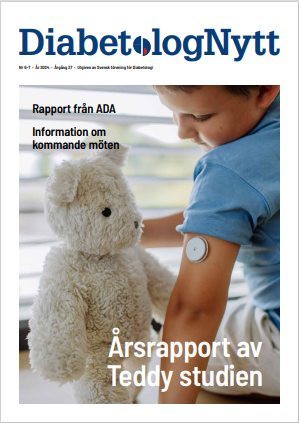Pressmeddelande • 2015-06-03 08:03 CEST
- 86 abstracts represent significant investment in diabetes research with a focus on individualised treatment approaches
- Notable late-breaker abstracts include data from a Phase III study comparing the efficacy and safety of dapagliflozin versus placebo as an add-on to saxagliptin and metformin in adults with type 2 diabetes
- New real-world data from an observational, retrospective claims database study comparing the risk of hospitalisation for heart failure between DPP-4 inhibitors vs. sulfonylureas and comparing saxagliptin with sitagliptin
- Data to advance understanding of the efficacy and safety of AstraZeneca’s comprehensive diabetes portfolio and the multiple diabetes-related cardiovascular risk factors
AstraZeneca today announced that 86 abstracts reporting results of the company’s research and development in diabetes have been accepted for presentationat the 75th Scientific Sessions of the American Diabetes Association (ADA) in Boston, 5-9 June 2015.
The abstracts include clinical data evaluating Forxiga® (dapagliflozin, marketed in the U.S. as Farxiga®), Bydureon® (exenatide extended-release for injectable suspension), Byetta® (exenatide) injection and Onglyza® (saxagliptin), as well as the investigational combination of saxagliptin and dapagliflozin. Among the abstracts accepted are studies evaluating long-term durability; safety and efficacy; medication adherence; and benefits and treatment effects across diverse subpopulations segmented by ethnicity and risk factors such as kidney disease and cardiovascular (CV) disease.
Notable late-breaker abstracts include data from a Phase III study comparing the efficacy and safety of dapagliflozin versus placebo as an add-on to saxagliptin and metformin in adults with type 2 diabetes who had inadequate glycaemic control, including an overview of the open-label lead-in period.
“The extensive scientific data at ADA underscore our research goals to better understand the long-term effects of newer classes of medicines across different patient populations,” said Elisabeth Björk, Vice President, Head of Cardiovascular and Metabolic Diseases, Global Medicines Development, AstraZeneca. “These data further demonstrate the value of our current portfolio to help address the needs of a broad range of patients with type 2 diabetes.”
In addition to advancing clinical and scientific discussions, AstraZeneca is also presenting a number of observational and medical outcomes studies, including new real-world data from an observational, retrospective claims database study comparing the risk of hospitalisation for heart failure between DPP-4 inhibitors vs. sulfonylureas and comparing saxagliptin with sitagliptin. [1]
Investigational new data
- Study of baseline albuminuria level versus the efficacy of dapagliflozin in patients with type 2 diabetes (#108-OR, Saturday 6 June, 1:45 p.m. EDT)[2]
- Assessment of dapagliflozin effects on albuminuria reductions in hypertensive patients with diabetes (#1176-P, Saturday 6 June, 12:30 p.m. EDT)[3]
- Pharmacodynamic comparison of dapagliflozin in patients with type 1 or type 2 diabetes (#1174-P, Saturday 6 June, 12:30 p.m. EDT)[4]
- An analysis of dapagliflozin on insulin resistance in type 2 diabetes (#1179-P, Saturday 6 June, noon EDT)[5]
- Pre-clinical analysis of the effects of a GLP-1 receptor agonist/glucagon co-agonist (MEDI0382) on weight (#2119–P, Sunday 7 June, noon EDT)[6]
Data assessing combination treatments and treatment approaches in select subgroups of patients
- An analysis of triple therapy with dapagliflozin versus placebo when added-on to saxagliptin plus metformin, including an overview of the open-label lead-in period (#133–LB, Sunday 7 June, noon EDT)[7]
- Study determining influential factors affecting preferences for the treatment of diabetes (#206–OR, Sunday 7 June, 2:15 p.m. EDT)[8]
-
A study examining the addition of saxagliptin, compared to placebo,treatment with dapagliflozin and metformin in patients with type 2 diabetes with inadequate glycaemic control (#104-OR, Saturday 6 June, 1:45 p.m. EDT)[9]
-
A study examining the addition of dapagliflozin, compared to placebo, to treatment with saxagliptin and metformin in patients with type 2 diabetes with inadequate glycaemic control (#105-OR, Saturday 6 June, 1:45 p.m. EDT)[10]
- Retrospective study of once-weekly exenatide treatment and adherence in elderly patients compared to other GLP-1 receptor agonists (#1144–P, Saturday 6 June, 11:30 a.m. EDT)[11]
- Comparison of one-year adherence, costs and utilisation between insured patients with type 2 diabetes initiating liraglutide or once-weekly exenatide (#1125-P, Saturday 6 June 11:30 a.m. EDT)[12]
- Dapagliflozin as a treatment option for African Americans and Hispanic Adult patients with type 2 diabetes (#1217–P, Sunday 7 June, noon EDT)[13]
- Saxagliptin as a treatment option for Caucasian, African Americans, Asian, and Hispanic patients with type 2 diabetes (#1248–P, Sunday 7 June, noon EDT)[14]
- Pre-clinical assessment of interactions of low dose combinations of GLP-1 receptor and GIP on glucose control in mice (#2350–P, Sunday 7 June, noon EDT)[15]
Data assessing the long-term effect and durability of AstraZeneca diabetes treatments
- Effect on dapagliflozin on weight over the first year of treatment through the subsequent three years (#103–OR, Saturday 6 June, 2:15 p.m. EDT)[16]
- Study of long-term effects of once-weekly exenatide on weight gain and hypoglycaemia, compared to insulin glargine. (#1120–P, Saturday 6 June, 11:30 a.m. EDT)[17]
- Effects of exenatide twice daily and once weekly on A1C in patients with type 2 diabetes and baseline A1C ≥10%. (#1126–P, Saturday 6 June, 11:30 a.m. EDT)[18]
- Analysis of the use of saxagliptin and cancer risk in the SAVOR trial (#11–OR, Friday 5 June, 4:15 p.m. EDT)[19]
Data assessing diabetes treatments and cardiovascular outcomes in patients at high CV risk
- Analysis of dapagliflozin on CV events in elderly patients with type 2 diabetes (#15–OR, Friday 5 June, 4:45 p.m. EDT)[20]
- SAVOR analysis on rates of CV risk and polyvascular disease in patients with type 2 diabetes (#56–OR, Saturday 6 June, 8:15 a.m. EDT)[21]
- Analysis of long-term efficacy of dapagliflozin treatment on patients with CV disease and type 2 diabetes (#106–OR, Saturday 6 June, 3:00 p.m. EDT)[22]
- Results of the SAVOR trial analysing CV outcomes in African Americans receiving treatment with saxagliptin (#15-LB; Sunday 7 June, noon EDT)[23]
- Observational analysis comparison of the risk of hospitalization for heart failure between DPP-4 inhibitors vs. sulfonylureas and with saxagliptin vs. sitagliptin
(#164–P, Sunday 7 June, noon EDT)1
The complete list of AstraZeneca data presentations can be accessed on the ADA website here.
Nyhetsinfo
www red DiabetologNytt
Ayesha Bharmal +44 20 7604 8034 (UK/Global)
Jacob Lund +46 8 553 260 20 (Sweden)
Michele Meixell +1 302 885 6351 (US)
Investor Enquiries
[1] Fu, A., et al. “Observational Study Comparing the Risk of Hospitalization for Heart Failure between Dipeptidyl Peptidase inhibtors vs. Sulfonlyureas and Saxaglitpin vs Sitagliptin.” American Diabetes Association Scientific Sessions 2015. Abstract #164-LB
[2] Parikh, S., et al. “Dapagliflozin Efficacy is Unaffected by Baseline Albuminuria Level in Patients with Type 2 Diabetes.” American Diabetes Association Scientific Sessions 2015. Abstract #108-OR
[3] Lambers-Heerspink. H., et al., “Dapagliflozin Reduces Albuminuria On Top of Renin-Angiotensin System Blockade in Hypertensive Diabetic Patients.” American Diabetes Association Scientific Sessions 2015. Abstract #1176-P
[4] Tang, W., et al. “Comparison of Pharmacodynamics of Dapagliflozin in Patients With Type 1 or Type 2 Diabetes Mellitus.” American Diabetes Association Scientific Sessions 2015. Abstract #1174-P
[5] Katz, A., et al. “Dapagliflozin and Insulin Resistance in Patients With Type 2 Diabetes.” American Diabetes Association Scientific Sessions 2015. Abstract #1179-P
[6] Agoram, B., et al. “Robust Anti-Obesity and Metabolic Effects of GLP-1/Glucagon Co-Agonist Peptide in Rodents and Non-Human Primates.” American Diabetes Association Scientific Sessions 2015. Abstract #2119
[7] Mathieu, C., et al. “Triple Therapy With Dapagliflozin (DAPA) Add-on to Saxagliptin (SAXA) Plus Metformin (MET): Characterization of the Open-Label SAXA+MET Lead-in Period of a Phase 3 Trial.” American Diabetes Association Scientific Sessions 2015. Abstract #133-LB
[8] Bell, K., et al. “Most influential factors determining patient preferences for diabetes treatment.” American Diabetes Association Scientific Sessions 2015. Abstract #206-OR
[9] Matthaei, S., et al. “A Randomized, Double-Blind Trial of Saxagliptin Add-on to Dapagliflozin + Metformin.” American Diabetes Association Scientific Sessions 2015. Abstract #104-OR
[10] Mathieu, C., et al. “A Randomized, Double-Blind, Phase 3 Trial of Dapagliflozin Add-on to Saxagliptin + Metformin in Type 2 Diabetes.” American Diabetes Association Scientific Sessions 2015. Abstract #105-OR
[11] Dufour, R., et al. “Real-World Adherence in Patients Aged ≥ 65 years With Type 2 Diabetes Mellitus for Exenatide QW, Liraglutide QD and Exenatide BID.” American Diabetes Association Scientific Sessions 2015. Abstract #1144-P
[12]Johnston, S., et al. “Comparison of 12-month Adherence and Healthcare Costs and Utilization Between Commercially-insured Patients with Type 2 Diabetes Mellitus Newly-initiating Liraglutide Once Daily or Exenatide Once Weekly in Real-World U.S. Clinical Practice.” American Diabetes Association Scientific Sessions 2015. Abstract #1125-P
[13] Moran, J., et al. “Efficacy and Safety of Dapagliflozin in Patients With Type 2 Diabetes: Outcomes by Race and Ethnicity.” American Diabetes Association Scientific Sessions 2015. Abstract #1217-P
[14] Barrett, Y., et al. “Efficacy and Safety of Saxagliptin in Patients With Type 2 Diabetes: Outcomes by Race and Ethnicity.” American Diabetes Association Scientific Sessions 2015. Abstract #1248-P
[15] Suckow, AT., et al. “Anti-obesity and anti-diabetic activity of combinations of GIP and GLP-1 Fc-fusion proteins in obese and diabetic mice.” American Diabetes Association Scientific Sessions 2015. Abstract 2350-P.
[16] Stenlof, K., et al. “Maintenance of Weight Loss with Dapagliflozin Versus Glipizide As Add-On to Metformin Over 4 Years.” American Diabetes Association Scientific Sessions 2015. Abstract #103-OR
[17] Trautmann, M., et al. “Three-year Efficacy and Safety of Exenatide Once Weekly: A Pooled Analysis of 3 Trials.” American Diabetes Association Scientific Sessions 2015. Abstract #1120-P
[18] Busch, R. et al. “Treatment of T2DM Patients with Baseline A1C ≥10% with Exenatide Twice Daily (BID), Exenatide Once Weekly (QW), or Basal Insulin: A Pooled Analysis of 20 Randomized Controlled Trials (RCTs).” American Diabetes Association Scientific Sessions 2015. Abstract #1126-P
[19] Leiter, L, et al. “Saxagliptin and cancer in the SAVOR Trial.” American Diabetes Association Scientific Sessions 2015. Abstract #11-OR
[20] Gause-Nilsson, I., et al. “No Increased Risk of Cardiovascular Events With Dapagliflozin in Elderly Patients with Type 2 Diabetes Mellitus, Cardiovascular Disease and Hypertension.” American Diabetes Association Scientific Sessions 2015. Abstract #15-OR
[21] Gutierrez, A., et al. “High Cardiovascular Risk of Polyvascular Disease in Diabetes – Insights from SAVOR-TIMI.” American Diabetes Association Scientific Sessions 2015. Abstract #56-OR
[22] Cefalu, W., et al. “Long-term Safety and Efficacy of Dapagliflozin in Patients with T2DM and Cardiovascular Disease.” American Diabetes Association Scientific Sessions 2015. Abstract #106-OR
[23] Dagogo-Jack, S., et al. “Cardiovascular outcomes of Saxagliptin Treatment in African Americans with Type 2 Diabetes: Results from the SAVOR-TIMI 53 Trial.” American Diabetes Association Scientific Sessions 2015. Abstract #15-LB





